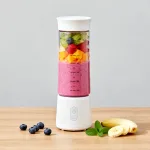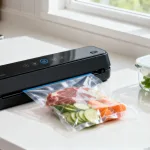Meal prep has become a staple for busy households — but let’s be honest: it can still be time-consuming, messy, and wasteful. Forgotten leftovers spoil in the fridge, pre-chopped veggies wilt before you use them, and blending the perfect smoothie often means measuring ingredients guesswork. That’s where smart food sealers and smart blender cups come in. These compact, connected tools transform how you prep, store, and enjoy food — saving you time, money, and frustration.
In this guide, we’ll break down why smart kitchen essentials are a must-have, how to choose the right sealer and blender cup for your needs, and how to use them to streamline your daily meals. Whether you’re a meal prep pro, a busy parent, or someone trying to eat healthier, these tools will make cooking at home easier than ever.
Why Smart Food Sealers & Blender Cups Are Game-Changers for Home Cooks
Traditional kitchen tools (like plastic wrap, manual blenders, or basic storage containers) often fall short when it comes to freshness, convenience, and precision. Smart sealers and blender cups solve these pain points with technology that adapts to your lifestyle — and your food.
Here’s why they’re worth the investment:
- Reduce Food Waste (and Save Money): The average household throws away $1,500 worth of food each year, according to the USDA. Smart food sealers remove air from storage bags, slowing bacterial growth and keeping food fresh 3–5 times longer than plastic wrap or containers. That means leftover chicken lasts a week instead of 3 days, and pre-chopped veggies stay crisp for 5 days instead of wilting in 2.
- Save Time on Meal Prep: Smart blender cups eliminate the need for measuring cups and recipe hunting. Many connect to apps with pre-programmed recipes (e.g., “Berry Protein Smoothie” or “Creamy Tomato Soup”) that tell you exactly how much of each ingredient to add — and then blend it to perfection with one tap. Smart sealers also speed up prep: no more fumbling with twist-ties or trying to squeeze air out of bags.
- Precision & Consistency: Whether you’re blending a smoothie for your morning commute or sealing marinated meat for grilling, smart tools ensure consistency. Blender cups with built-in scales let you measure ingredients by weight (for more accurate results), and sealers with adjustable vacuum strength let you customize how much air is removed (critical for delicate foods like bread or berries).
- Portability & Versatility: Most smart blender cups are compact enough to take to work or the gym — no need to transfer smoothies to a separate bottle. Smart sealers are also lightweight (many are countertop-friendly) and work with a variety of bag sizes, from small snack bags to large meal-sized bags.
Smart Food Sealers: Your Key to Longer-Lasting Freshness
Smart food sealers use vacuum technology to remove air from specially designed bags, creating an airtight seal that locks in freshness. But not all sealers are the same — the best models add smart features that make storage even easier.
How Smart Food Sealers Work (and Why They’re Better Than Traditional Methods)
Traditional storage methods (plastic wrap, zip-top bags, containers) leave air inside, which causes oxidation (spoilage) and freezer burn (for frozen foods). Smart sealers solve this by:
- Removing Air: A motorized pump sucks air out of the bag, reducing oxygen levels (which bacteria need to grow).
- Creating an Airtight Seal: Heat seals the bag shut, preventing air from re-entering.
- Adding Smart Controls: Unlike manual sealers (which require you to guess how much air to remove), smart models let you adjust vacuum strength, seal time, and even choose presets for different foods.
For example:
- Delicate foods (berries, bread, salad greens) need low vacuum strength — too much suction will crush them.
- Wet foods (marinated meat, soups, sauces) need a “wet seal” preset, which stops suction before liquid is pulled into the sealer.
- Dry foods (grains, nuts, snacks) can handle high vacuum strength for maximum freshness.
Key Features to Look for in a Smart Food Sealer
Not all smart sealers are created equal. Here’s what to prioritize when shopping:
- Adjustable Vacuum Strength: Look for at least 3 levels (low, medium, high) to handle different foods. Some models have auto-detect sensors that adjust suction based on the food inside the bag (e.g., it reduces suction if it detects liquid).
- Seal Time Control: Thicker bags need longer seal times to ensure a tight closure. Smart sealers let you adjust seal time (or use auto-seal, which detects bag thickness) to avoid weak seals that break open.
- App Connectivity: The best apps offer more than just controls — they might include:
- Expiration date trackers (e.g., “Your sealed chicken expires in 3 days”).
- Meal planning tools (e.g., “Seal 4 portions of rice for meal prep this week”).
- Bag size recommendations (e.g., “Use a 8x12 bag for 1 pound of ground beef”).
- Compact Design: Counter space is precious — look for sealers that are less than 12 inches wide and 5 inches tall. Some models are even portable (battery-powered) for camping or RV trips.
- Compatibility with Bag Types: Most sealers work with branded bags (e.g., FoodSaver, Ninja), but some are compatible with generic vacuum bags (which are cheaper). Check if the sealer can also seal containers (via a hose attachment) — this is great for storing leftovers in glass containers.
- Easy Cleaning: Look for sealers with removable drip trays (to catch liquid from wet foods) and dishwasher-safe parts. A non-stick sealing strip also makes cleaning easier — food won’t stick to it.
How to Use a Smart Food Sealer: Step-by-Step Guide
Using a smart food sealer is simple — follow these steps for perfect results every time:
- Prepare Your Food:
- Cut food into portion sizes (e.g., 4-ounce portions of chicken for weeknight meals).
- Pat wet foods (like marinated meat) dry with a paper towel — excess liquid can interfere with sealing.
- For soups or sauces: Freeze them in a container first, then transfer to a bag for sealing (this prevents liquid from being sucked into the sealer).
- Load the Bag:
- Place food in a vacuum bag, leaving 2–3 inches of space at the top (this gives the sealer room to work).
- If using a countertop sealer, insert the top of the bag into the sealer’s opening (make sure it’s aligned with the sealing strip).
- Choose Your Settings:
- Open the companion app or use the sealer’s control panel to select a preset (e.g., “Wet Food,” “Delicate,” “Dry Food”) or adjust vacuum strength and seal time.
- For example: Use “Delicate” for berries, “Wet Food” for marinated pork, and “Dry Food” for nuts.
- Start Sealing:
- Press the “Seal” button (or tap “Start” in the app). The sealer will suck out air, then seal the bag shut.
- If the sealer detects liquid (for wet foods), it will pause suction and seal early to prevent mess.
- Label and Store:
- Use a marker to write the date on the bag (or let the app track it for you).
- Store sealed foods in the fridge (for 3–7 days) or freezer (for 3–12 months, depending on the food).
Smart Blender Cups: Beyond Smoothies — A Tool for Every Meal
Smart blender cups (also called “personal blenders” or “single-serve blenders”) are more than just smoothie makers. They’re compact, powerful, and connected — making them perfect for everything from morning lattes to evening soups.
Why Smart Blender Cups Are Better Than Traditional Blenders
Traditional blenders are bulky, hard to clean, and often require you to make large batches (which means leftovers go to waste). Smart blender cups fix this with:
- Single-Serve Size: Most cups hold 16–20 ounces — perfect for one person. No more making a 64-ounce smoothie that goes bad in 2 days.
- One-Touch Blending: Pre-programmed settings (e.g., “Smoothie,” “Soup,” “Nut Butter”) take the guesswork out of blending. Just add ingredients, press a button, and walk away.
- App Integration: Apps let you browse thousands of recipes, customize blends (e.g., “Extra thick smoothie”), and even track nutrition (e.g., “This smoothie has 25g of protein”).
- Easy Cleaning: Most cups are dishwasher-safe (top rack), and some have self-cleaning modes (just add water and soap, then press “Clean”).
Key Features to Look for in a Smart Blender Cup
When shopping for a smart blender cup, focus on these features:
- Motor Power: Look for a motor with at least 300 watts — this is strong enough to blend frozen fruit, nuts, and leafy greens. Higher wattage (500+ watts) is better for tough ingredients (like almonds for nut butter).
- Blade Quality: Stainless steel blades are durable and sharp. Look for blades with multiple edges (e.g., 4-point blades) — they blend ingredients more evenly than single-edge blades.
- App Functionality: The best apps offer:
- A recipe library (sorted by meal type, diet, or ingredient — e.g., “Vegan Smoothies,” “Low-Carb Soups”).
- Nutrition tracking (input ingredients, and the app calculates calories, protein, carbs, etc.).
- Custom presets (save your favorite blend settings — e.g., “My Morning Smoothie: 30 seconds on high”).
- Battery Life (for Portable Models): If you want to use the blender on the go (e.g., at work), look for a battery-powered model with at least 10 blends per charge. USB charging is a plus (easy to charge in your car or at your desk).
- Material: BPA-free plastic is lightweight and affordable, but glass cups are better for hot liquids (they don’t retain odors) and durability. Some models offer both options.
- Heat Function (for Soups): If you love hot meals, look for a blender cup with a heating element. These models can blend and heat soup in 5–10 minutes — perfect for lunch at your desk.
How to Use a Smart Blender Cup: Tips for Perfect Blends Every Time
Whether you’re making a smoothie, soup, or nut butter, these tips will help you get the most out of your smart blender cup:
- Layer Ingredients Correctly:
- Liquid first (milk, water, juice): This helps the blades spin smoothly and prevents ingredients from getting stuck.
- Soft ingredients next (yogurt, bananas, spinach): They blend easily and help break down harder ingredients.
- Hard/frozen ingredients last (frozen fruit, ice, nuts): Placing them on top lets the liquid and soft ingredients pull them down into the blades.
- Don’t Overfill the Cup:Most cups have a “max fill” line — never exceed it. Overfilling causes ingredients to spill out and prevents the blender from working properly. For thick blends (like nut butter), fill the cup only halfway.
- Use the Right Preset:
- Smoothies: Use the “Smoothie” preset (usually 30–60 seconds on medium-high speed). If the blend is too thick, add a splash more liquid and blend again.
- Soups: For cold soups (like gazpacho), use the “Smoothie” preset. For hot soups, use the “Soup” preset (it heats and blends at the same time).
- Nut Butter: Use the “Nut Butter” preset (low speed for 2–3 minutes) — stop halfway to scrape down the sides of the cup with a spatula.
- Clean It Immediately:The longer you wait to clean the cup, the harder it is to remove stuck-on food (like dried smoothie). If you’re on the go, rinse the cup with warm water and a drop of soap, then clean it thoroughly when you get home. For self-cleaning models, run the “Clean” cycle right after use.
How to Pair Smart Food Sealers & Blender Cups for Ultimate Meal Prep
Smart food sealers and blender cups work even better together — here’s how to use them to streamline your weekly meal prep:
- Prep Smoothie Packs:
- Use the blender cup’s app to find a smoothie recipe (e.g., “Berry Oat Smoothie”).
- Measure out frozen fruit, oats, and protein powder, then place them in a vacuum bag.
- Use the smart sealer to seal the bag (use “Delicate” preset to avoid crushing oats).
- Store the packs in the freezer. When you’re ready to make a smoothie, just empty the pack into the blender cup, add milk, and press “Smoothie.”
- Batch-Cook Soups & Sauces:
- Use the blender cup to make a large batch of soup (e.g., butternut squash soup).
- Let the soup cool, then divide it into portion-sized vacuum bags.
- Seal the bags (use “Wet Food” preset) and freeze. When you want soup, thaw the bag in the fridge overnight, then heat it in the microwave or on the stovetop.
- Marinate Meat Faster:
- Place meat (chicken, steak, pork) in a vacuum bag, add marinade.
- Seal the bag (use “Wet Food” preset) — vacuum sealing pushes marinade into the meat, cutting marinating time from 4 hours to 30 minutes.
- Use the blender cup to make a fresh marinade (e.g., garlic-herb marinade) — the app can recommend a recipe that pairs with your meat.
- Store Pre-Chopped Veggies:
- Chop veggies (bell peppers, onions, carrots) for weeknight meals.
- Dry them with a paper towel, then place them in vacuum bags.
- Seal the bags (use “Delicate” preset) and store in the fridge. The veggies will stay crisp for 5–7 days — perfect for stir-fries, salads, or omelets.
Final Thoughts
Smart food sealers and blender cups aren’t just “fancy” kitchen tools — they’re practical solutions for anyone who wants to eat healthier, save time, and reduce waste. By investing in these essentials, you’ll spend less time prepping and cleaning, and more time enjoying home-cooked meals.
Whether you’re a busy professional who needs quick breakfasts, a parent who wants to feed their kids nutritious snacks, or someone who hates throwing away spoiled food, these tools will transform your kitchen routine. Start with one (we recommend a smart blender cup — it’s the most versatile), then add a sealer once you see how much time it saves.

















